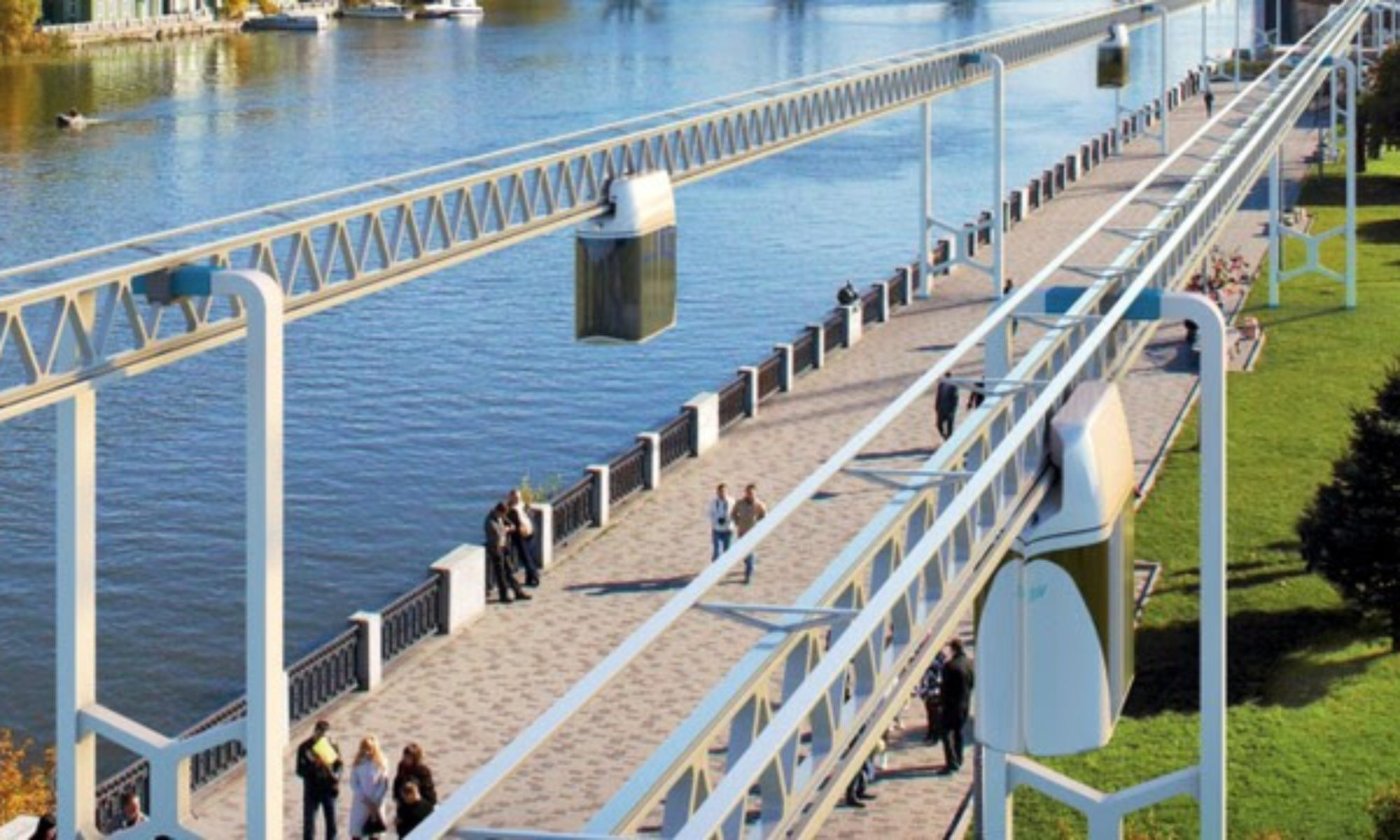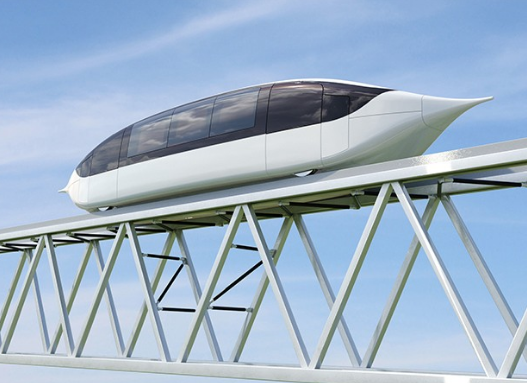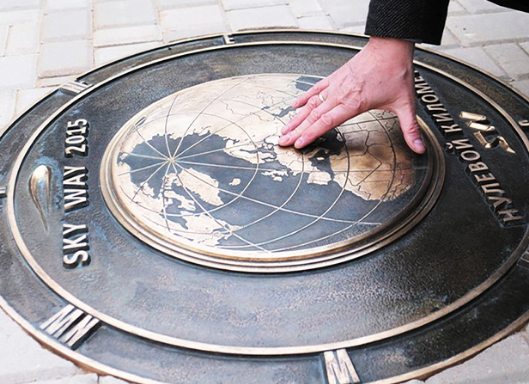MODERNIZATION OF ROLLING SURFACE ON SKYWAY TRUSS OVERPASS 10
August 2019
As shown by tests conducted at SkyWay EcoTechnoPark in 2017-2019, even a perfectly smooth backlash-free welded seam causes a light knocking of wheels on the rails caused by the local variation of steel hardness. This may be acceptable for urban transport running at speeds up to 150 km/h. The noise level and running smoothness of the vehicles demonstrated at EcoTechnoPark meet all the necessary requirements and are quite comfortable for passengers. EcoFest 2019 guests will be able to make sure of it. However, for high-speed transport, the existing rail configuration may not be sufficient. In this regard, in order to improve the high-speed track structure, it was decided to modernize the raceway. The solutions worked outed by SkyWay design organization provided the opportunity to eliminate transverse welded seams almost along the entire length of the rolling surface at the test section of the high-speed complex. Absolutely unique technology should allow not only to confirm the expected features of running smoothness and noise level of high-speed SkyWay transport (up to 500 km/h), but also to make passengers’ feelings extremely comfortable when riding at such speeds. In addition, this solution allows to achieve even more reliable operation of the anti-derailment system, and the experimental coating of the raceway is designed to make the track structure even more durable. Tests with the prototype of high-speed unibus on the updated track are planned to begin in the near future. Last week, the pod was delivered to SkyWay EcoTechnoPark, there are tests ahead, which, by the way, can also be witnessed by guests of EcoFest 2019 on August 17. Let us recall that the urban/high-speed passenger transport system is the first object in SkyWay EcoTechnoPark on the date of construction start. As it was supposed, the route would be extended by 20 km across Belarusian woods and marshland. Such distance is needed for comfortable acceleration, demonstration of the claimed speed of 500 km/h and safe braking. However, the circumstances were such that granting of the originally promised strip of land to the developers of Yunitsky SkyWay transport was refused, which eventually led to the transfer of part of the work on the creation of high-speed SkyWay to the UAE, where the leaders of that State believed in the creators of the future transport, allocating several needed land plots for various types of innovative transport systems – both ready for implementation and promising ones.

However, the 1st line in the Republic of Belarus, planned as a booster section for a high-speed vehicle, has found many other applications, demonstrating the versatility of the track structure and allowing to conduct various types of tests with most of the existing types of rolling stock. And, although the tests of the string rail have already shown that we are moving in the right direction, and the data collected during the trial operation of the 1st line has become a valuable contribution to the development of technology; it is time to move on, which necessitated the modernization of this truss track structure. Wear-resistant and high-strength grades of steel are used for the construction of experimental tracks in #SkyWay #EcoTechnoPark, the string rail itself has a high strength, rigidity and evenness, it is technologically advanced in manufacturing and installation, has low material intensity and a wide range of operating temperatures: from +70 to -70°C. Therefore, even in this version SkyWay track structure does not have technological and expansion gaps along its entire length, but only welded ones (the railhead is welded into one length). In this regard, installation of an additional, hard-face steel head at the initial stage was impractical, since, in addition to the rise in the project cost at the time of funding shortage and the lack of confidence in the fundamental ability of string-rail transport to function among the public, it did not make sense.
The main task was to demonstrate the working efficiency of such systems, where the pre-stressed elements are: overpass, rail, steel ropes inside and even its concrete filler, to some extent. SkyWay string rail can be manufactured in different versions depending on the loads and operating conditions: both with a steel head and without it, and the latter does not have to look like a separate structural element, because primarily the railhead means a flat steel surface on which a wheel rests and rolls. The track structure of the 1st line was tested in the version when the function of the railhead was performed by the body itself, which showed the viability of such a technical solution from the viewpoint of comfort of movement both in terms of shaking and vibration, and noise load on passengers. We told about one component of this work in detail in the report on string rail tests in the laboratories of the Belarusian Research Institute of construction. As a reminder, it has successfully passed the test for noise then, i.e. it can be safely said that string rails produce much less noise than conventional railway ones, and the reduction of this indicator is achieved primarily through the use of special concrete to fill them.
The noise level of the vehicle depends on several parameters, but in this news we speak about the noise of “wheel-rail” system caused by roughness elements on the working surfaces. For example, in #Japan, the problem of noise pollution along Shinkansen lines was partially solved by installing noise shields, removal of rolling surface irregularities using composite brake shoes, and subsequently by grinding the rails. Nevertheless, it is the noise from the wheel-rail pair that still dominates, and progress here has been less significant. It is very likely that this factor was the reason for the increased attention of specialists from Japan, who came to Minsk, “for inspiration”, according to their own words. The mistakes of Japanese pioneers are taken into account in our project, and the team of SkyWay Technologies Co. headed by General designer Anatoly #Yunitsky continues to work on a record low level of noise emission in string-rail. The tests of high-speed unibus that will begin soon on the updated track structure, are not intended to demonstrate the claimed speed of 500 km/h. This is not possible at such a short distance. However, the tests will allow to check a lot of units, structural elements and various functions that can be worked out on this very track structure. The module itself was ready almost a year ago and exhibited to the world community at the largest international forum InnoTrans 2018. And now its prototype (“mule”) will be released on the line – an accurate, outwardly almost indistinguishable copy, technically identical, however, devoid of very expensive finishing elements and other parts that do not need testing and do not affect the speed.
Release prepared by: Text Mikhail Kirichenko Photo Evgeny Petrov Editor Evgeny Petrov
Использование этого материала сайта группы компаний SkyWay в Интернет-пространстве допускается только при обязательном размещении ссылки на источник публикации: https://rsw-systems.com/news/rail-head
© https://rsw-systems.com/
• • • • • • • Italian / Italiano • • • • • • •
MODERNIZZAZIONE DELLA SUPERFICIE DI LAMINAZIONE SULLA SUPERVISIONE DI TRUSS SKYWAY 10
Come dimostrato dai test condotti su SkyWay EcoTechnoPark nel 2017-2019, anche una cucitura saldata perfettamente liscia e priva di gioco provoca un leggero urto delle ruote sui binari causato dalla variazione locale della durezza dell’acciaio. Ciò può essere accettabile per il trasporto urbano che corre a velocità fino a 150 km / h. Il livello di rumore e la scorrevolezza dei veicoli dimostrati a EcoTechnoPark soddisfano tutti i requisiti necessari e sono abbastanza comodi per i passeggeri. Gli ospiti di EcoFest 2019 potranno esserne sicuri. Tuttavia, per il trasporto ad alta velocità, la configurazione ferroviaria esistente potrebbe non essere sufficiente. A questo proposito, al fine di migliorare la struttura della pista ad alta velocità, è stato deciso di modernizzare la pista. Le soluzioni elaborate dall’organizzazione di progettazione SkyWay hanno offerto l’opportunità di eliminare le cuciture saldate trasversali quasi per l’intera lunghezza della superficie di rotolamento nella sezione di prova del complesso ad alta velocità. Una tecnologia assolutamente unica dovrebbe consentire non solo di confermare le caratteristiche attese della scorrevolezza di marcia e del livello di rumore del trasporto SkyWay ad alta velocità (fino a 500 km / h), ma anche di rendere estremamente confortevoli le sensazioni dei passeggeri quando viaggiano a tali velocità. Inoltre, questa soluzione consente di ottenere un funzionamento ancora più affidabile del sistema anti-deragliamento e il rivestimento sperimentale della pista è progettato per rendere la struttura del binario ancora più resistente.
I test con il prototipo di #unibus ad alta velocità sulla pista aggiornata dovrebbero iniziare nel prossimo futuro. La scorsa settimana, il pod è stato consegnato a SkyWay EcoTechnoPark, ci sono test in anticipo, che, a proposito, possono essere testimoniati anche dagli ospiti dell’EcoFest 2019 il 17 agosto. Ricordiamo che il sistema di trasporto urbano / ad alta velocità dei passeggeri è il primo oggetto in SkyWay EcoTechnoPark alla data di inizio della costruzione. Come si supponeva, il percorso sarebbe stato esteso di 20 km attraverso boschi e paludi bielorussi. Tale distanza è necessaria per un’accelerazione confortevole, dimostrazione della velocità dichiarata di 500 km / he frenata sicura. Tuttavia, le circostanze erano tali che la concessione della striscia di terra originariamente promessa agli sviluppatori del trasporto SkyWay di Yunitsky fu rifiutata, il che alla fine portò al trasferimento di parte del lavoro sulla creazione di SkyWay ad alta velocità negli Emirati Arabi Uniti, dove il i leader di quello Stato credevano nei creatori del futuro trasporto, assegnando diversi appezzamenti di terreno necessari per vari tipi di sistemi di trasporto innovativi, sia pronti per l’implementazione che promettenti. Tuttavia, la prima linea nella Repubblica di Bielorussia, progettata come sezione di richiamo per un veicolo ad alta velocità, ha trovato molte altre applicazioni, dimostrando la versatilità della struttura del binario e permettendo di condurre vari tipi di test con la maggior parte dei tipi esistenti di materiale rotabile.
E, sebbene i test della guida di stringa abbiano già dimostrato che ci stiamo muovendo nella giusta direzione, e i dati raccolti durante l’operazione di prova della 1a linea sono diventati un prezioso contributo allo sviluppo della tecnologia; è tempo di andare avanti, il che ha reso necessario l’ammodernamento di questa struttura a traliccio. Gradi di acciaio resistenti all’usura e ad alta resistenza sono utilizzati per la costruzione di binari sperimentali in SkyWay EcoTechnoPark, il binario stesso ha un’elevata resistenza, rigidità e uniformità, è tecnologicamente avanzato nella produzione e installazione, ha bassa intensità del materiale e un ampia gamma di temperature di funzionamento: da +70 a -70 ° C.
Pertanto, anche in questa versione la struttura del binario SkyWay non presenta spazi tecnologici ed espansivi su tutta la sua lunghezza, ma solo quelli saldati (la testa del binario è saldata su una lunghezza). A questo proposito, l’installazione di una testa aggiuntiva in acciaio a faccia dura nella fase iniziale era poco pratica, poiché, oltre all’aumento del costo del progetto al momento della carenza di finanziamenti e alla mancanza di fiducia nella capacità fondamentale della stringa- il trasporto ferroviario per funzionare tra il pubblico, non aveva senso. Il compito principale era dimostrare l’efficienza operativa di tali sistemi, in cui gli elementi precompressi sono: cavalcavia, binario, funi d’acciaio all’interno e persino il suo riempitivo di cemento, in una certa misura.
Il binario SkyWay può essere prodotto in diverse versioni a seconda dei carichi e delle condizioni operative: entrambi con una testa in acciaio e senza di esso, e quest’ultimo non deve apparire come un elemento strutturale separato, perché principalmente la testa del binario significa una superficie piatta in acciaio su che una ruota riposa e rotola.
La struttura del binario della 1a linea è stata testata nella versione in cui la funzione della testa della rotaia è stata eseguita dal corpo stesso, il che ha dimostrato la fattibilità di tale soluzione tecnica dal punto di vista del comfort di movimento sia in termini di scuotimento che di vibrazione, e carico di rumore sui passeggeri. Abbiamo parlato in dettaglio di un componente di questo lavoro nel rapporto sui test delle ferrovie a corda nei laboratori dell’Istituto di ricerca bielorusso di costruzione. Come promemoria, ha superato con successo il test del rumore, quindi si può tranquillamente affermare che i binari delle corde producono molto meno rumore rispetto a quelli delle ferrovie convenzionali e la riduzione di questo indicatore si ottiene principalmente attraverso l’uso di cemento speciale per riempirli . Il livello di rumore del veicolo dipende da diversi parametri, ma in questa notizia parliamo del rumore del sistema “ruota-rotaia” causato da elementi di rugosità sulle superfici di lavoro.
Ad esempio, in Giappone, il problema dell’inquinamento acustico lungo le linee di Shinkansen è stato parzialmente risolto installando protezioni antirumore, eliminando le irregolarità della superficie di rotolamento mediante ganasce dei freni compositi e successivamente rettificando le rotaie. Tuttavia, è ancora il rumore della coppia ruota-rotaia a dominare, e qui i progressi sono stati meno significativi. È molto probabile che questo fattore sia stato il motivo della crescente attenzione degli specialisti dal Giappone, che sono venuti a Minsk, “per ispirazione”, secondo le loro stesse parole. Gli errori dei pionieri giapponesi sono presi in considerazione nel nostro progetto e il team di SkyWay Technologies Co. guidato dal designer generale Anatoly Yunitsky continua a lavorare su un livello record di emissioni sonore a livello di binari. Le prove del unibus ad alta velocità che inizieranno presto sulla struttura della pista aggiornata, non intendono dimostrare la velocità dichiarata di 500 km / h. Questo non è possibile a così breve distanza.
Tuttavia, i test consentiranno di verificare molte unità, elementi strutturali e varie funzioni che possono essere elaborate su questa struttura di binari. Il modulo stesso era pronto quasi un anno fa ed esposto alla comunità mondiale nel più grande forum internazionale InnoTrans 2018. E ora il suo prototipo (“mulo”) sarà rilasciato sulla linea – una copia accurata, esternamente quasi indistinguibile, tecnicamente identica, tuttavia, privo di elementi di finitura molto costosi e di altre parti che non necessitano di prove e non influiscono sulla velocità.
Rilascio preparato da: Testo Mikhail Kirichenko Foto Evgeny Petrov Editor Evgeny Petrov
• • • • • • • Albanian / Shqip • • • • • • •
MODERNIZIMI I SIPERFAQES SE MBULESES nen MBROJTJEN E SKYWAY TRUSS 10 overpass
Siç u tregua nga testet e kryera në #SkyWay EcoTechnoPark në 2017-2019, edhe një qepje e salduar në mënyrë të përkryer e pa lënjë shkakton një ndikim të lehtë të rrotave në shinat e shkaktuara nga variacioni lokal i ngurtësisë së çelikut. Kjo mund të jetë e pranueshme për transportin urban që funksionon me shpejtësi deri në 150 km / orë. Niveli i zhurmës dhe qetësia e automjeteve të demonstruara në EcoTechnoPark plotësojnë të gjitha kërkesat e nevojshme dhe janë mjaft të rehatshme për pasagjerët. Vizitorët e EcoFest 2019 mund të jenë të sigurt. Sidoqoftë, për transport me shpejtësi të lartë, konfigurimi hekurudhor ekzistues mund të mos jetë i mjaftueshëm. Në këtë drejtim, për të përmirësuar strukturën e pista me shpejtësi të lartë, u vendos që të modernizohej pista. Zgjidhjet e zhvilluara nga organizata e projektimit SkyWay ofruan mundësinë për të eleminuar qepjet e ngjitur tërthor pothuajse për të gjithë gjatësinë e sipërfaqes së rrotullimit në seksionin e provave të montimit me shpejtësi të lartë.
Një teknologji absolutisht unike duhet të lejojë jo vetëm që të konfirmojë karakteristikat e pritura të rrjedhjes së qetë dhe nivelin e zhurmës së transportit SkyWay me shpejtësi të lartë (deri në 500 km / orë), por gjithashtu të bëjë ndjesitë e pasagjerëve jashtëzakonisht të rehatshme kur udhëtojnë për në shpejtësi të tilla. Për më tepër, kjo zgjidhje lejon një funksionim edhe më të besueshëm të sistemit anti-derailment dhe veshja eksperimentale e pistës është krijuar për të bërë strukturën e pista edhe më rezistente.
Testimi me prototipin e unibusit me shpejtësi të lartë në pista të azhurnuar duhet të fillojë në të ardhmen e afërt. Javën e kaluar, pod u dorëzua në SkyWay EcoTechnoPark, ka teste paraprakisht, të cilat, nga rruga, mund të dëshmohen edhe nga mysafirët e EcoFest 2019 në 17 gusht. Kujtojmë se sistemi i transportit udhëtar / urban me shpejtësi të lartë është objekti i parë në SkyWay EcoTechnoPark në datën e fillimit të ndërtimit. Siç u mendua, rruga do të ishte shtrirë për 20 km përmes pyjeve dhe kënetave bjelloruse. Kjo distancë është e nevojshme për përshpejtim të rehatshëm, duke demonstruar shpejtësinë e deklaruar prej 500 km / orë dhe frenim të sigurt. Sidoqoftë, rrethanat ishin të tilla që dhënia e shiritit të premtuar fillimisht për zhvilluesit e transportit Yunitsky SkyWay u refuzua, gjë që përfundimisht çoi në transferimin e disa prej punimeve për krijimin e SkyWay me shpejtësi të lartë në Emiratet e Bashkuara Arabe, ku drejtuesit e këtij shteti besuan në krijuesit e transportit të ardhshëm, duke caktuar parcela të ndryshme toke të nevojshme për lloje të ndryshme të sistemeve të reja të transportit, të gatshëm për zbatim dhe premtues.
Sidoqoftë, linja e parë në Republikën e Bjellorusisë, e projektuar si seksion tërheqës për një automjet me shpejtësi të lartë, ka gjetur shumë aplikacione të tjera, duke demonstruar shkathtësinë e strukturës së pista dhe duke lejuar kryerjen e llojeve të ndryshme të testeve me llojet më ekzistuese të rezervave. Dhe, megjithëse testet e drejtuesve të vargjeve kanë treguar tashmë që ne po lëvizim në drejtimin e duhur, dhe të dhënat e mbledhura gjatë funksionimit të testit të rreshtit të 1-të janë bërë një kontribut i vlefshëm në zhvillimin e teknologjisë; është koha për të vazhduar më tej, gjë që e bëri të domosdoshme modernizimin e kësaj strukture kutie.
Shkalla e rezistencës së lartë dhe rezistencës ndaj konsumit përdoren për ndërtimin e pistave eksperimentale në SkyWay EcoTechnoPark, pista në vetvete ka forcë të lartë, ngurtësi dhe uniformitet, është e avancuar teknologjikisht në prodhim dhe instalim, ka intensitet të ulët materiali dhe një gamë e gjerë e temperaturave të funksionimit: nga 70 në -70 ° Celsius. Prandaj, edhe në këtë version struktura e binarit SkyWay nuk ka hapësira teknologjike dhe ekspansive përgjatë gjithë gjatësisë së saj, por vetëm ato të salduara (koka e pistes është ngjitur në një gjatësi). Në këtë drejtim, instalimi i një koke çeliku shtesë të vagonit ne shtytjen në fazën fillestare ishte jopraktike, pasi, përveç rritjes së kostos së projektit në kohën e mungesës së financimit dhe mungesës së besimit në kapacitetin themelor të vargut, transporti hekurudhor për ta bërë atë të funksionojë në publik nuk kishte kuptim. Detyra kryesore ishte demonstrimi i efikasitetit operacional të këtyre sistemeve, në të cilat elementët e parafytyruar janë: mbikalimet, pista, kabllot e çelikut brenda dhe madje edhe mbushësi i tij i çimentos, deri në një farë mase.
Hekurudha me binare SkyWay mund të prodhohet në versione të ndryshme në varësi të ngarkesave dhe kushteve të funksionimit: si me kokë çeliku ashtu edhe pa të, dhe kjo e fundit nuk ka pse të duket si një element strukturor i veçantë, sepse kryesisht hekurudha nënkupton një sipërfaqe të sheshtë çeliku në të cilën një rrotë mbështetet dhe rrokulliset. Struktura e pista e rreshtit të pare u testua në versionin kur funksioni i hekurudhës kryhej nga vetë trupi, i cili tregoi qëndrueshmërinë e një zgjidhjeje të tillë teknike nga pikëpamja e komoditetit të lëvizjes, si në aspektin e lëkundjes, ashtu edhe të dridhjes, dhe ngarkesa e zhurmës për pasagjerët. Ne treguam në lidhje me një komponent të kësaj pune në detaje në raportin mbi testet hekurudhorë të binareve në laboratorët e Institutit të Kërkimeve Bjelloruse të ndërtimeve. Si kujtesë, ajo ka kaluar me sukses testin për zhurmë, atëherë, dmth mund të thuhet me siguri se binarët e telave prodhojnë shumë më pak zhurmë se ato hekurudhore konvencionale, dhe zvogëlimi i këtij treguesi arrihet kryesisht përmes përdorimit të betonit special për plotësimin e tyre . Niveli i zhurmës së automjetit varet nga disa parametra, por në këtë lajm ne flasim për zhurmën e sistemit “hekurudhor me rrota” të shkaktuar nga elementë vrazhdës në sipërfaqet e punës. Për shembull, në Japoni, problemi i ndotjes së zhurmës përgjatë linjave Shinkansen u zgjidh pjesërisht me instalimin e mburojave të zhurmës, heqjen e parregullsive të sipërfaqes së rrotullimit duke përdorur materiale të frenave të përbërë dhe më pas duke bluar shinat. Sidoqoftë, është zhurma nga çifti i hekurudhave-rrota që ende mbizotëron, dhe përparimi këtu ka qenë më pak i rëndësishëm. Ka shumë të ngjarë që ky faktor ishte arsyeja e vëmendjes së shtuar të specialistëve nga Japonia, të cilët erdhën në Minsk, “për frymëzim”, sipas fjalëve të tyre. Gabimet e pionierëve japonezë merren parasysh në projektin tonë, dhe ekipi i SkyWay Technologies Co. kryesuar nga stilisti i Përgjithshëm Anatoly Yunitsky vazhdon të punojë në një nivel rekord të ulët të emetimit të zhurmës në trasportin hekurudhor. Testet e #unibus me shpejtësi të lartë që do të fillojnë së shpejti në strukturën e azhornuar të pistave, nuk kanë për qëllim të demonstrojnë shpejtësinë e pretenduar prej 500 km / orë. Kjo nuk është e mundur në një distancë kaq të shkurtër. Sidoqoftë, testet do të lejojnë të kontrollohen shumë njësi, elementë strukturorë dhe funksione të ndryshme që mund të punohen në këtë strukturë shumë të mirë.
Vetë moduli ishte gati gati një vit më parë dhe u ekspozua para komunitetit botëror në forumin më të madh ndërkombëtar InnoTrans 2018. Dhe tani prototipi i tij (“mushka”) do të dalë në linjë – një kopje e saktë, e jashtme pothuajse e padallueshme, teknikisht identike, megjithatë, pa elementë shumë të shtrenjtë të mbarimit dhe pjesëve të tjera që nuk kanë nevojë për prova dhe nuk ndikojnë në shpejtësinë.
Shkrimi i përgatitur nga: Teksti Mikhail Kirichenko Photo Evgeny Petrov Redaktori i Evgeny Petrov
Translate / Traduzione / Perkthimi © #JoeArtidFejzo 2019








0